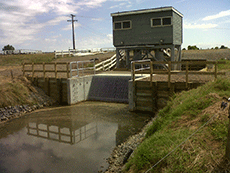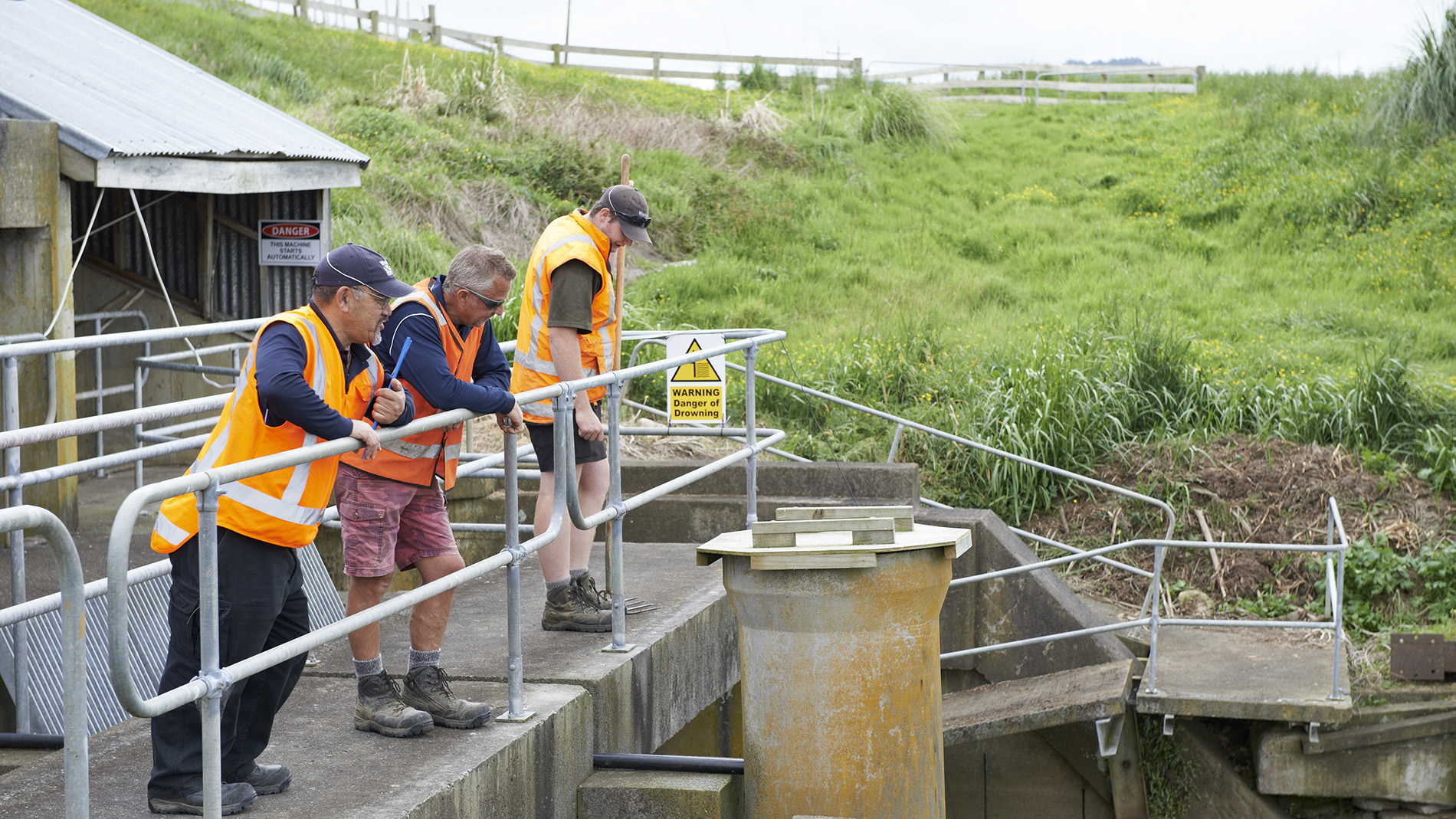Protecting people and land from floods
The Waikato region has 20 large rivers and about 1400 small river systems, so flooding can be an issue in some areas. Flooding commonly happens when rivers and streams cannot cope with heavy rainfall.
Waikato Regional Council is responsible for flood protection under the Soil Conservation and Flood Protection Act 1941 and the Public Works Act 1981. We manage multi-million dollar systems that protect communities, schools, roads, farms and other vital resource, keeping land draining freely in specific geographic areas where schemes have been agreed with communities.
Our flood protection assets and systems include stopbanks, floodgates, pump stations, spillways and channels, all linked and managed by computer monitoring of river levels and flows.
There are over 90 individual land drainage schemes, each locally funded through targeted rating.
Did you know?
The flood protection systems managed by Waikato Regional Council:
- have a replacement value of $1.2 billion
- realise and protect community infrastructure that generates over $2.2 billion of economic activity annually
- protect over 300,000 ha of land.
Land management and licensing
Land was acquired for the various flood protection schemes as far back as the 1920’s with the Waihou Ohinemuri River Improvement Scheme.
Land acquisition and development of the flood protection schemes continue today, as required for stop bank design flood level maintenance in sinking soils, channels widening or pump upgrades in flood prone areas.
The Land Management team, part of the wider asset management team, manages council’s interests in land and ensures that the necessary agreements, easements and encumbrances are in place and that the portfolio is managed to the prescribed levels of service. Standards are in place to protect the interests of all parties involved, including Crown agencies, iwi, district councils and the general public and to meet council’s responsibilities under legislation including health and safety impacts.
Iwi and crown co-management
Arrangements between the Crown and iwi ushered in a new era of co-management of the Waikato and Waipā rivers and the lands surrounding them. Waikato Regional Council has five Joint Management Agreements (JMAs) and one Co-managed Lands agreement with Waikato rohe iwi. These derive from the provisions within the iwi specific Treaty Settlement legislation. Read about the Waikato River and Waipā River co-management.
The land management team:
- regularly inspects the land portfolio and promotes best farm and property management practices
- liaises with councils engineers in scheme impacts on lands, renewals & maintenance planning
- ensures grazing licences are managed to meet terms and conditions
- negotiates new acquisitions and disposals
- conducts and presents annual and five-yearly licence fee reviews and presents alternative land use options to council and co-management policies
- implements the Land Management Strategy (under development).
Scheme areas
There are currently over 300 licences. These are all for land located in the Waihou, Piako and Lower Waikato zones. Select an area below to see a map showing licensed land locations.
You can also read our information sheet on looking after your stopbank and license area for more on grazing licence area responsibilities.
Contact us online for more information, or call 0800 800 401 and ask for our Council Lands Officer or Land and Licenses Assistant.
Stopbanks
Without stopbanks, large areas of our region, including the north Waikato and Hauraki Plains, would be under water for months at a time.
Most of the Waikato Regional Council’s 620 km of stopbanks are in the Waihou-Piako and Lower Waikato zones. These two zone schemes were developed in the 1960s and many stopbanks are now more than 50 years old.
Learn more about stopbanks and view our stopbank locations, below.
Stopbank location maps
 Asset management policies and plans
Asset management policies and plans
Waikato Regional Council has an obligation to manage its infrastructure assets effectively.
The asset management policies and plans below set out our requirements and rationales for our management approach.
Sustainable infrastructure (SIDF)
We're developing a new framework (Sustainable Infrastructure Decision-Making Framework) for making decisions on investments in critical flood protection and drainage assets.
-
Asset management policy - Flood protection, river management and land drainage infrastructural assets
Ext. link
-
Regional asset management plan 2024
Ext. link
-
Infrastructure Assets Accounting Policy
Ext. link
-
Lake Taupō asset management plan
Ext. link
-
Upper Waikato asset management plan
Ext. link
-
Land drainage management plan
Ext. link
Frequently asked questions
Are you prepared?
Find out if you live in a flood prone area
- Get a land information memorandum (LIM) for your property from your district or city council. Any known hazards that may affect a property will be on a LIM report.
- Check your regional council rates bill to see if you are paying for flood protection and/or land drainage. If you are, there is a reason for that.
- Check out our Hazards Portal (see link on this page) to learn where river flood hazard zones are.
Before a flood (if you are in a flood prone area)
- Keep assets and other structures away from flood prone areas. This may already be restricted by planning permission but if not you may save yourself future insurance difficulties and damage to your property.
- Identify your closest high points for emergency evacuation, for people and animals, including pets and livestock.
- Plant vegetation in areas where rainwater may run off to stabilise the ground and help absorb water. If you’re a landowner with a stream on your property and need help with or advice on debris removal, erosion protection and planting, please speak to one of our river management officers. Call 0800 800 401.
- Sign up to our flood warning service if you live in an area that could potentially be affected by floods. The council electronically monitors a number of its rivers to track water levels. When they reach a nominated level, an SMS or email alert is sent to anyone in the area who has signed up for alerts.
During a flood, or if flood is imminent
- Keep up to date with weather events as they unfold on Flood Room Live. Flood Room Live gives information on weather, rainfall, river levels, road closures, emergency contacts and Civil Defence.
- Listen to the radio for latest information.
- Wear long pants, a long-sleeved shirt, and sturdy shoes. The most common injury following a disaster is cut feet.
- Move valuable household possessions to upper floors or safe ground if time permits, and fill bathtubs, sinks, and jugs with clean water in case water becomes contaminated.
- Move livestock to higher ground and prevent animals from accessing pooled water where there is a risk of contamination from effluent or chemicals.
- If Civil Defence says to evacuate, do so immediately. Leave early enough to avoid being marooned by flooded roads.
- Never try to walk, swim, or drive through swift water. Many flood fatalities are caused by people attempting to drive through water, or people playing in high water. If it is moving swiftly, even water 15 centimetres deep can sweep you off your feet. As little as 30cm may cause you to lose control of your vehicle.





To ask for help or report a problem, contact us
Tell us how we can improve the information on this page. (optional)